Arthur Dove and Helen Torr, renowned modernist artists, celebrated in Heckscher Museum of Art exhibit
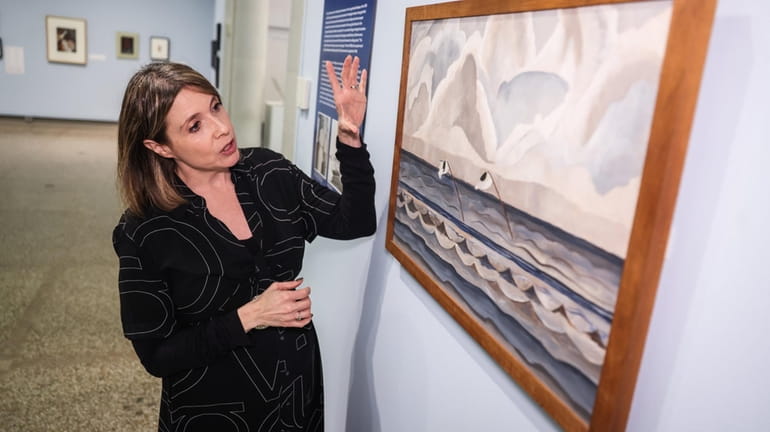
Renowned modernist artists Arthur Dove and Helen Torr came to New York City for its arts scene. But they found their home — and their inspiration — on Long Island.
The couple first settled on the Island in the 1920s, docking their sailboat in Huntington Harbor. They split their time between the boat, living there in fair weather, and the Ketewomoke Yacht Club in Halesite, where they were caretakers in the winter. They left for upstate New York for five years to settle family affairs, but in 1938 they returned and purchased a small cottage in Centerport, where they immersed themselves in nature.
Despite battling serious illness, Dove — an acclaimed abstract artist — created some of his most celebrated works during this time, Heckscher Museum of Art curator Karli Wurzelbacher said.
“They loved Long Island and their ‘salt life,’ ” she said. “They were longing to come home to Long Island.”
Now, an exhibit at the Huntington museum is showcasing their work and nature’s influence on them. Curators hope it will help introduce them to a new generation.
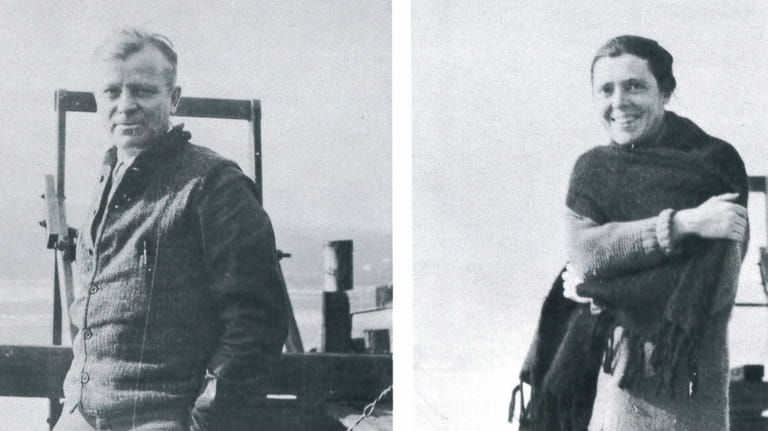
Arthur Dove and Helen Torr in 1924. Credit: Estate of Arthur Dove
A cottage ‘soundwalk’
The exhibit, “Salt Life: Arthur Dove and Helen Torr,” celebrates the museum’s 25th year of stewardship of the couple’s Centerport home, known as the Dove/Torr Cottage. As part of that celebration, the museum has created a free “soundwalk,” available through the Bloomberg Connects app, that allows visitors to the cottage to learn about the history of the Centershore Road home and Dove and Torr’s life there. The cottage grounds are also home to “A Vision Against Context,” a large-scale, kinetic stainless steel sculpture by local artist Susan Buroker that draws inspiration from Torr’s life and work.
“You can see that nature was inherent in everything they did,” said Heather Arnet, executive director of the museum. “The cottage is where they lived and painted. The art came from that natural world. It’s a wonderful experience to go and experience the same environment.”
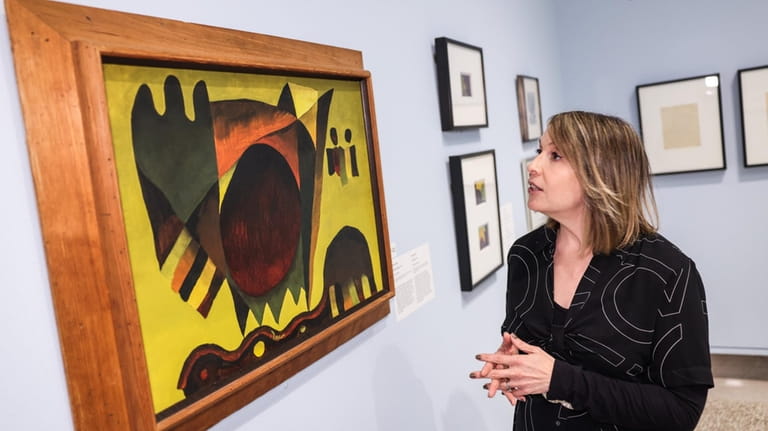
Heckscher Museum executive director, Heather Arnet, with Dove's painting, "Indian Summer." Credit: Newsday / Steve Pfost
Setting sail
Dove and Torr met in 1922 when both lived in Connecticut, both married to other people. They headed to New York City, but, realizing they didn’t want to live there, they first docked their boat in upper Manhattan and then sailed around Long Island Sound until they found Huntington Harbor. There, they lived on their double-masted sailboat, The Mona, and in the winter they became caretakers at the Ketewomoke Yacht Club in Halesite, where they had access to the upstairs rooms, Wurzelbacher said.
Torr’s 1929 oil painting “Oyster Stakes” was based on a view she sketched as they were returning home from sailing. Visitors to the exhibit will also notice a familiar scene in Torr’s 1932 oil painting “Heckscher Park,” which shows ducks clambering out of the water onto a small hill. The museum, which is situated in the park, was a favorite rainy-day destination of the pair, Wurzelbacher said.
While Huntington suited them for their work and its easy water access, it also offered regular train service along with ferry service to the city from Halesite for business. In the city, the painterly crowd they hung with included Marsden Hartley, John Marin and Georgia O’Keeffe, so “influences are running in all directions,” Wurzelbacher said. Many of the artists shared the same gallery, often called 291 for its location on Fifth Avenue, which was run by Alfred Stieglitz, an influential photographer who helped acquaint Americans with modern and abstract art. Stieglitz was married to O’Keeffe and represented Dove.
In 1932, the pair married after Dove’s first wife, who had refused to grant him a divorce, died. A year later, they moved to upstate Geneva, where Dove grew up, to settle his mother’s estate.
They moved back to Long Island in 1938, when they bought the 500-square-foot former Centerport post office and general store.
The cottage is along the shore of Titus Mill Pond. Ducks, geese and gulls are frequent visitors to the shallow water outside the home, their calls and honks mingling with the lapping water. Visiting the site gives a sense of what the two experienced and how they channeled that into their art.
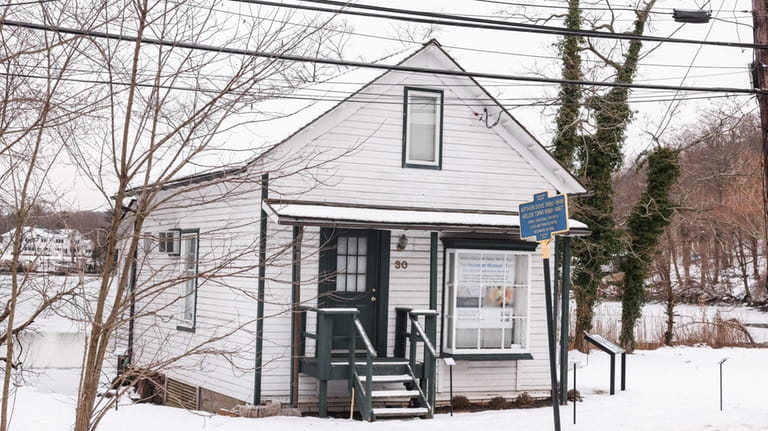
Dove and Torr's cottage in Centerport. Credit: Newsday / Steve Pfost
‘It is beautiful’
Writing to friends after purchasing the cottage, Wurzelbacher said, Torr commented, “We feel this is the loveliest situation we have ever had.” Dove agreed: “I love this swashbuckling around the salt water. ... Everyone seems quite delighted with this place. It is beautiful.”
But while the two were enthralled by their new home, their life there was not without difficulty. Most of their time at the cottage, Dove, who was in his late 50s when they moved there, was in poor health, dealing with heart attacks, kidney disease and pneumonia. Torr stopped painting and became his caretaker, although she continued to draw.
“It’s too simple to say the illness forced her to stop painting,” Wurzelbacher said. “It’s a choice she freely made. It’s one of the reasons the show should resonate with people. After the pandemic and feeling the effects of illness, we know how draining that is.”
Dove, who was largely housebound, painted hundreds of watercolors, as well as the 1941 oil “Indian Summer,” which uses rich colors and shapes evocative of the season. In his last years, he mainly painted small images on paper that could fit in his lap, often depicting what he saw from a window in the cottage.
Torr did not return to painting after Dove died in 1946, although she continued to draw and, according to her sister, Mary Torr Rehm, was known for her handmade Christmas cards. “She was Arthur Dove’s greatest champion, and he was hers,” Wurzelbacher said, “but he was no longer there to share her art with. It’s heartbreaking.”
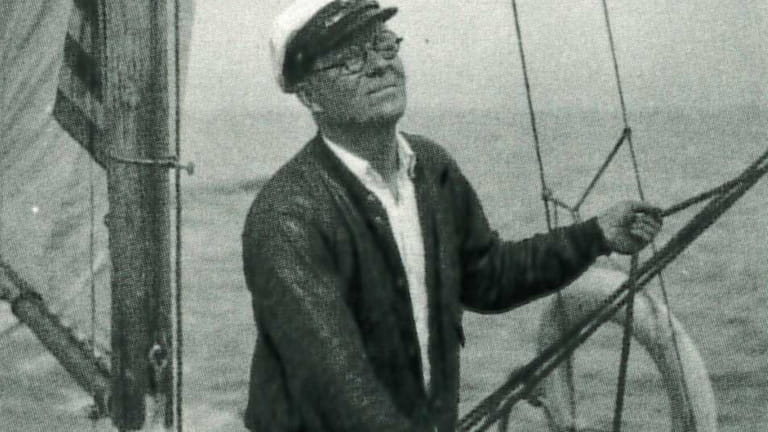
Dove aboard the couple's boat, The Mona. Credit: Estate of Arthur Dove
‘The most celebrated' American abstractionist
After Dove died, Torr advocated for his work and helped promote his artistic contributions. “Arthur Dove was the most celebrated abstract American artist during his lifetime,” Wurzelbacher said. Noting all modern artists had a hard time getting abstract works accepted, and being a female painter added another level of difficulty, she said, “Helen Torr did not reach the same level of acclaim.”
The pair had their only joint exhibit at Stieglitz’s gallery, An American Place, in 1933, but Torr found her work garnered little attention. A critic remarked, “She pays her husband the compliment of following in his footsteps.”
Wurzelbacher disagrees with the blanket dismissal. Torr, or “Reds” as she was known because of her auburn hair, was an artist well before she met Dove. “They shared the same environment, were absorbing the same ideas and developed this visual language together,” she said.
Wurzelbacher noted the Heckscher Museum has championed Torr since it acquired her paintings and drawings from her sister in 1968. “The Heckscher has stewarded her legacy for decades,” she said.
The museum acquired the couple’s Centerport home in 1998. It is part of the Historic Artists’ Homes and Studios program, administered by the National Trust for Historic Preservation, and Artists’ Sites of Long Island, an initiative of the Robert David Lion Gardiner Foundation.
The property helps tell the story of how the couple created, according to Wurzelbacher.
“What’s important is the site and its location, them looking out the windows and the views fueling their art,” she said. “What’s evocative and important is where the cottage is located and the environment that inspired their works.”
Abstract art is about extracting the essence of its subjects, versus showing every detail. “They pared what they saw down to line, color, shape and composition to get at the feelings evoked by what they saw,” Wurzelbacher said. “They bring their experience of the world to it.”
In addition to considering the environment’s impact on their work and how illness affected their work, visitors to the museum, located three miles from the cottage, should note Dove and Torr’s willingness to experiment with colors, materials and form, mixing their own paints and sometimes using shells, sand or metal. Brushes, pigments and books outlining new theories and techniques are included in the show.
It’s an exhibit particularly suited to the Heckscher Museum, Wurzelbacher said. “We’re the only institution that can show their art in the place that inspired it: the weather and seasonal shifts, appreciation for the water, birds flying in the sky,” she said.
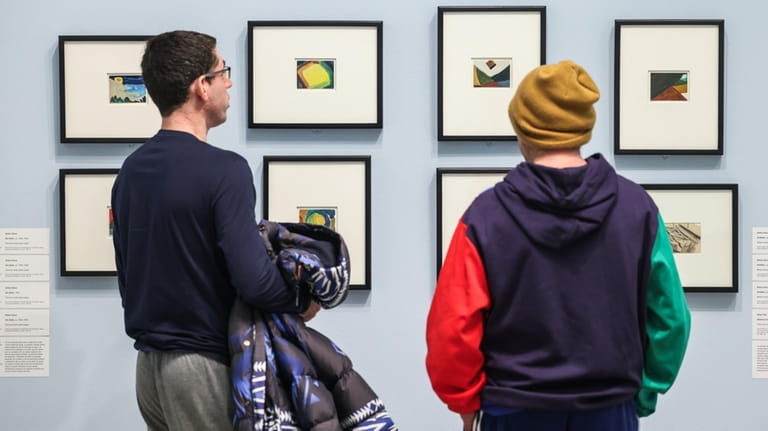
Patrons view the exhibit at the Heckscher Museum. Credit: Newsday / Steve Pfost
Girls Inc.
Visitors can also get a sense of Dove and Torr’s life at the cottage through the new soundwalk. Last summer, middle school students involved with the nonprofit Girls Inc. spent time at the cottage, read Torr’s letters and journals and saw her art, said Arnet, the museum’s executive director. They learned about the constraints women faced during Torr’s time, then were recorded reading from her letters, she said.
A series of small signs provide a QR code that visitors can scan to access audio content available through the free Bloomberg Connects app. There are also tactile signs in Braille.
“The soundwalks are a new way to interpret the Dove/Torr Cottage and bring their story to life,” Arnet said. “We’re using new technology to bring these stories to life at visitors’ convenience. We hope this makes it more accessible.”
The grounds are open to the public, but the cottage itself is open infrequently. An open house is scheduled for July 13.
“The cottage is very bare-bones, and it’s very fragile,” Arnet said. “We’re trying to preserve it.”
Arnet hopes the cottage and its soundwalk will help visitors connect with the couple and their work, especially Torr, who lived in the Centerport home until her death in 1967.
“The natural environment was so key to their art. ... Now we can visit it, see her paintings and hear about her with the recordings,” she said. “It’s quite profound.”
Middle schoolers with Girls Inc. recording nature sounds for a Heckscher Museum "soundwalk." Credit: The Heckscher Museum of Art
EXHIBIT DETAILS
Salt Life: Arthur Dove and Helen Torr opened at the Heckscher Museum of Art in November 2023 and will run through March 10. The exhibit was developed in partnership with the Amon Carter Museum of American Art in Fort Worth, Texas, where it showed last summer. Dove’s son, William C. Dove, had donated 40 to 50 of his father’s small watercolors to the museum, as well as several other institutions.
When the exhibit closes, the paintings from the Texas museum will return home. The Heckscher Museum’s Dove and Torr paintings will remain there but will not be on display, Wurzelbacher said.
On Feb. 27, Metropolitan Museum of Art conservator Rachel Mustalish will discuss preserving Dove’s work in a virtual presentation. Museum membership and registration is required to attend the panel. Register here.
Also part of the Heckscher show is a film that captures the environment surrounding the Dove/Torr Cottage, located at 30 Centershore Rd. in Centerport. Museum educator Alyssa Matthews created the video from footage taken at various times of day and in different seasons throughout 2023. View the video here.
The Heckscher Museum of Art is at 2 Prime Ave. in Huntington. Hours are 12 to 5 p.m. Thursday through Sunday. Admission is free for members and children under 13. There is a $5 suggested admission fee for all others. For more information, call 631-380-3230 or visit heckscher.org.
— Kay Blough
Details on the charges in body-parts case ... Gilgo-related search continues ... Airport travel record ... Upgrading Penn Station area
Details on the charges in body-parts case ... Gilgo-related search continues ... Airport travel record ... Upgrading Penn Station area
